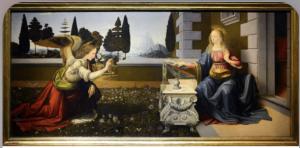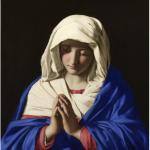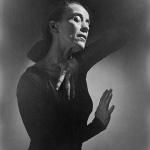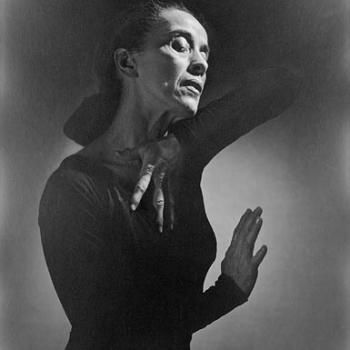
This 1472 version was a very famous iteration of the biblical story by Da Vinci. It widely differs from Tanner’s creative interpretation. Picture courtesy of wiki media Commons
Analyzing Religious Art Series: A Deeper Exploration
In this ongoing series for An Exhibition Of Art History, I am going to be analyzing famous works of religious art. The focus will be religious symbolism, the history of the piece, biblical history and reference and my personal interpretation of the piece. I hope you enjoy this series as it will take on a wide variety of artistic expressions and spiritual avenues. Each article will represent one piece to keep a clean and deep understanding of it’s history and message. My first article explored the famous work of Rembrandt, The Return Of the Prodigal Son.
The second article of the series focused on The Calling of Saint Matthew by Caravaggio. You may follow this link to read more. The Virgin in Prayer by Giovanni Battista Salvi da Sassoferrato was the subject of the last article.
Today, we will be discussing The Annunciation by the African-American painter Henry Ossawa Tanner.
The Annunciation 1898: The Holy Trinity in precise theological devices
I have come across many iterations of The Annunciation and though Tanner’s is my favorite, the indisputable nature of subjectivity in the art world begs one to consider all shades and interpretations. Fra Angelico, Leonardo Da Vinci, Raphael, El Greco, Rossetti all have different variations on the same theme for the biblical story.
I find Tanner’s artistic interpretation of the archangel Gabriel and arrangement of religious symbolism to be unparalleled in creativity, mastery of detail and capturing the spirit of the biblical story Luke 1:26–38 has inspired.
The story of Luke 1:26-38 is of the virgin Mary of Nazareth, a young Jewish girl, who is favored by God to carry His son, Jesus Christ. God sends the Archangel Gabriel down to send this heavenly message to Mary in person, explaining to her:
35 The angel answered, “The Holy Spirit will come on you, and the power of the Most Highwill overshadow you. So the holy one to be born will be called[a] the Son of God. 36 Even Elizabeth your relative is going to have a child in her old age, and she who was said to be unable to conceive is in her sixth month. 37 For no word from God will ever fail.”
38 “I am the Lord’s servant,” Mary answered. “May your word to me be fulfilled.” Then the angel left her.
The Revd. Canon Ian Morter from the online platform Exeter Cathedral was keen to point out several cleverly placed religious symbols in his pithy and concise article:
“Finally, there are the little theological devices.The ruck in the carpet symbolising division between heaven and earth, the presence of the angel in the celestial side and Mary in the terrestrial.The three earthen-wear pots, one on the shelf, the one at Gabriel’s “feet” and the one on the far right behind Mary form a triangle around her.I see this as signifying the presence of the Holy Trinity. God the Father and Holy Spirit in heaven and God the Son now becoming man on earth, this also amplifies Mary’s future as the vessel that will bear Our Blessed Lord.”
I found Morter’s insights of this piece to be deeply illuminating. The details of the ruck in the carpet between Mary and the Archangel was shown in a such an intricate way to represent a line between heaven and earth. It was so intricate in fact, it seemed possibly ordinary, and could’ve been dismissed as a mere addition to create realism. And the placing of the three earthen pots. I see the way it envelops the piece, creating that holy sense of protection around Mary. Truly, it is a masterwork of design and development of research through biblical accuracy.
The Burning Bush effect and the comfort of home
Benjamin Tucker Tanner, Ossawa Tanner’s father, was a bishop in the African Methodist Episcopal Church and engrained in his children a deep love for the Bible. Tanner was deeply religious even as his artistic career path flourished even as his father initially discouraged the trade. His first religious paintings were Daniel in the Lion’s Den followed two years later by The Resurrection of Lazarus.
These two paintings were marked with high distinction at the Paris Salon where they were exhibited and created a huge buzz, wherein a popularity spun around the art world for his mastery of the religious subject matter and his talent for detail. After a trip to Egypt and Palestine in 1897, Tanner came back with the intent of creating The Annuciation, all with the images of the Orient, such as their architecture, culture and landscape in mind to evoke such a vivid representation.
We can see the homely nature of the scene in Tanner’s Annuciation clearly, even with the clear Middle Eastern inspiration and the darker skin tones and curly, black hair of Mary, the young Jewish girl from Nazareth(Israel).
I find the choice of the domestic scene laid out bare and simple, to be what truly represents Annunciation, and carries the heart and soul of the biblical history in my opinion. The beautiful, luminous pillar of light that is represented as Gabriel the Archangel, is what truly stands out to me in this piece. Mary, in a quiet rapture, wide-eyed and hands folded together in a prayer stance, is in a quiet contemplation as she hears the angel’s message. The comforts of home are magnified by the expression of heavenly light in the shadowy room.
It reminds me of one of my favorite biblical films, The Prince of Egypt(1998). The Burning Bush scene in particular. I found the intrinsic beauty of the glowing, burning bush so comforting and truly healing in the sense that the voice was in Moses’ own voice(a subjective view of the Voice of God), and as he placed his hand in the flames, it did not burn. As I continue to deepen my gaze of the masterful work of Henry Ossawa Tanner’s Annunciation, I feel this sensation and warmth settling in my bones and soul. Both mediums capture the Love of God and a deep appreciation of God’s message and will. Here is the link to the scene in the film I described.
I hope you find the comforts I described not only in this truly astonishing piece but also in the biblical history it represents.














